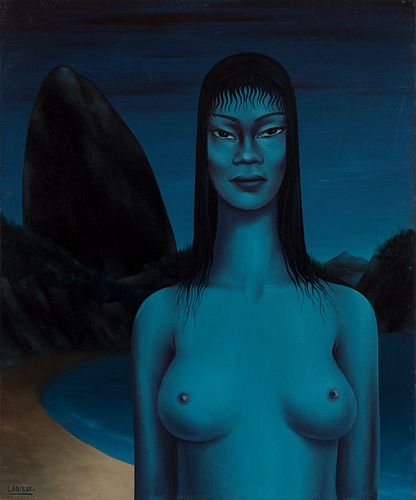FÉLIX LABISSE (France, 1905- 1982). "Le soir du 18 decembre", 1963. Oil on canvas. Work registered in "Labisse Catalogue de l'oeuvre peint 1927-197
Lot 60
About Seller
Setdart Auction House
Carrer Aragó 346
Barcelona
Spain
Setdart Subastas was born in 2004 and is currently the first online art auction in Spain with solidity, prestige and reliability guaranteed by our more than 60,000 users. Setdart has a young, dynamic and enterprising team ready to successfully manage the purchase and sale of art works through custom...Read more
Estimate:
EUR€15,000 - EUR€16,000
$16,129.03 - $17,204.30
Absentee vs Live bid
Two ways to bid:
- Leave a max absentee bid and the platform will bid on your behalf up to your maximum bid during the live auction.
- Bid live during the auction and your bids will be submitted real-time to the auctioneer.
Bid Increments
| Price | Bid Increment |
|---|---|
| EUR€0 | EUR€10 |
| EUR€200 | EUR€25 |
| EUR€500 | EUR€50 |
| EUR€1,000 | EUR€100 |
| EUR€3,000 | EUR€200 |
| EUR€5,000 | EUR€500 |
| EUR€10,000 | EUR€1,000 |
| EUR€20,000 | EUR€2,000 |
| EUR€50,000 | EUR€5,000 |
About Auction
By Setdart Auction House
Oct 27, 2021
Set Reminder
2021-10-27 10:00:00
2021-10-27 10:00:00
America/New_York
Bidsquare
Bidsquare : 19th & 20th Century Paintings & Decorative Arts
https://www.bidsquare.com/auctions/setdart-auction-house/19th-20th-century-paintings-decorative-arts-7767
Setdart Auction House sofia@setdart.com
Setdart Auction House sofia@setdart.com
- Lot Description
FÉLIX LABISSE (France, 1905- 1982). "Le soir du 18 decembre", 1963. Oil on canvas. Work registered in "Labisse Catalogue de l'oeuvre peint 1927-1979" Isy Brachot Éditeur, Bruxelles 1979, nr. 391 of 395. Signed, dated and titled on the back. Size: 65 x 54 cm. French surrealist painter whom the surrealists have refused to recognize as one of their own. To the margin of André Breton's movement, he was linked between 1947 and 1948, due to his friendship with Christian Dotremont, with the adventure of the revolutionary surrealism. In the early 1940s, his work was recognized and supported by Robert Desnos, Paul Eluard, Philippe Soupault, Jacques Prévert. Patrick Waldberg dedicated an important monograph in 1970.The Labisse family originally came from Douai, in northern France, but after World War I moved to Ostend, Belgium, where they set up a fishing boat. Labisse served in Cambrai and made his debut as a painter in 1922, under the protective wing of James Ensor. Together with his friend Henri Storck, he founded the "Galerie d'Art Moderne" and the "Club du Cinéma de Ostend". From 1932, he settled in Paris, where he became friends with Antonin Artaud, Jean-Louis Barrault and Robert Desnos, who dedicated a text to him. In 1935 he joined the group of surrealists and met Paul Delvaux, Max Ernst, André Masson and René Magritte, as well as Jacques Prévert and Raymond Queneau. Mobilized in 1939 at the outbreak of World War II, he returned to Paris from the front in 1940 and became one of the leading artists among the young French painters. From 1943 he devoted himself entirely to painting and scenography. In 1947 he joined the group "Surréalism Révolutionnaire, founded in Paris by Noel Arnaud and in Brussels by Christian Dotremont. The group, which does not last 18 months, aims" to reconcile the need for revolutionary action based on Marxism-Leninism and freedom of research and expression specific to surrealism. "The condemnation of the group by André Breton marks the first major split in surrealism after World War II. In June 1951 he made the sets for the play "The Devil and the Good God" by Jean-Paul Sartre, staged by Louis Jouvet. During this time he spent his time between Paris and Knokke Le Zoute, in the Netherlands. At the end of 1951, he moved to Neuilly-sur-Seine, near Paris, and continued to exhibit in France and the rest of Europe. In 1966 he was made a member of the Academy of Fine Arts and was buried in the Douai cemetery. Parallel to his career as a painter, Labisse directed a career as a decorator for theater, dance and opera. His early creations were influenced by Ensor and Flemish expressionism. His mature work, under the sign of metamorphosis, such as the nude woman with the head of Leona de la Felicity to be loved (1943), explores the limits of fantasy, ritual, magic or eroticism ... . His female characters with lascivious bodies, soft shapes and raw colors, evolve in a strange and timeless world. "His sadism, served by a coldly figurative invoice, which does not always avoid the surrealist cliché, is that of twilight ceremonies where the blood gushes slowly. The women he subjects to his dreams are sometimes Dressed in slit stockings or erotic harness. "In 1964-1965, appear the first blue women who will contribute to his celebrity: The Impeccable Catechumen (1964), Maria d'Apparecida16 (1965), "Turquoise Bath" (1968).
- Shipping Info
-
In-house shipping available. Please inquire at admin@setdart.com.
-
- Buyer's Premium



 EUR
EUR CAD
CAD AUD
AUD GBP
GBP MXN
MXN HKD
HKD CNY
CNY MYR
MYR SEK
SEK SGD
SGD CHF
CHF THB
THB

















